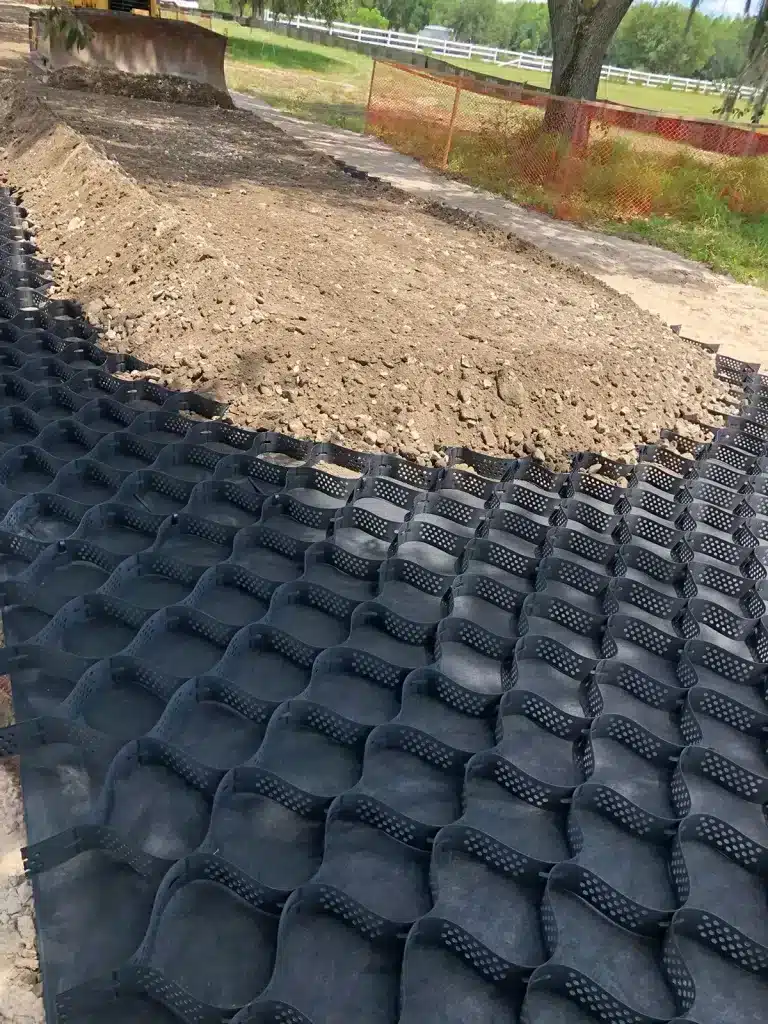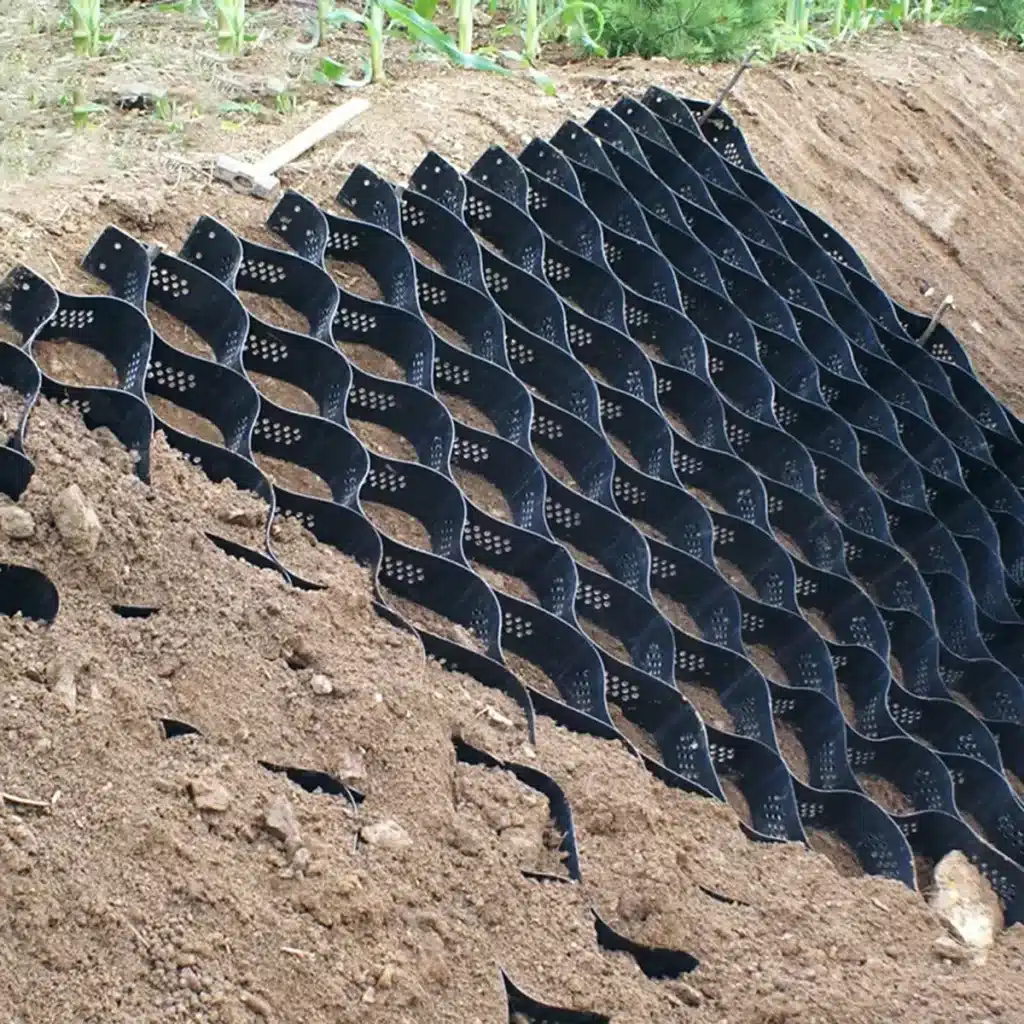+86-159 9860 6917
info@geofantex.com
geofantex@gmail.com
+86-400-8266163-44899
Geocell Erosion Control Products
Geocell erosion control products are innovative geosynthetic materials widely used for soil stabilization and erosion prevention. Made from a three-dimensional honeycomb-like structure, geocells are typically constructed from durable materials like high-density polyethylene (HDPE). Once expanded, geocells form stable cells that confine soil, preventing erosion and enhancing soil stability.
These products are ideal for various applications, including slope protection, riverbank stabilization, and embankment reinforcement for roads and railways. Compared to traditional erosion control methods, geocells are easier to install, cost-effective, and promote vegetation growth, maintaining ecological balance. Their durability and environmental benefits make geocells a superior choice for long-term erosion control.

Slope Protection
Slope Protection with Geocells: A Durable and Sustainable Solution
Slope protection is essential for preventing soil erosion and maintaining the stability of slopes in various environments, from road embankments to natural landscapes. Geocells provide an effective and sustainable solution for slope stabilization, offering long-term protection against erosion while promoting vegetation growth.
Geocells, with their three-dimensional cellular structure, work by confining soil within each cell, which reduces the movement of soil particles and helps to disperse the force of water runoff. This provides a solid foundation for vegetation, allowing plants to grow and further stabilize the slope.
Benefits of Geocell Slope Protection:
- Enhanced Stability: Geocells reinforce slopes by reducing the risk of soil erosion caused by water runoff.
- Cost-effective: Geocells are affordable compared to traditional methods like concrete or riprap, with lower installation and maintenance costs.
- Environmentally Friendly: Geocells allow for natural vegetation to grow, which helps restore the natural ecosystem and enhances the aesthetic value of the area.
- Durability: Made from high-quality materials like HDPE, geocells are resistant to UV degradation and weathering, ensuring long-lasting performance in harsh conditions.
Geocells are an excellent solution for slope protection, offering an environmentally friendly, cost-effective, and durable method to prevent erosion and maintain soil stability in both engineered and natural settings.

Flood and Water Control
Flood and Water Control – Summary
Flood and water control are essential for protecting communities and ecosystems from the destructive effects of floods.
- Key Methods: Includes levees, dams, retention basins, and floodplain management.
- Types of Approaches: Structural methods (e.g., floodwalls) and non-structural methods (e.g., land use regulations).
- Technological Role: Data and forecasting technologies improve flood prediction and management.
- Global Examples: Success stories from the Netherlands, New Orleans, and China demonstrate the importance of both engineering and natural solutions in flood control.
Flood and water control strategies must combine infrastructure, regulatory measures, and nature-based solutions to effectively reduce flood risks and enhance community resilience.

What Is a Geocell?
A geocell is a three-dimensional, honeycomb-like structure made from polymer materials like HDPE (high-density polyethylene). It is used in civil engineering and construction to stabilize soil, reduce erosion, and improve load-bearing capacity.
Key Features:
- Stabilization: Geocells are used to stabilize weak soils, making them stronger and more resilient.
- Erosion Control: They help prevent soil erosion by confining and reinforcing the ground surface.
- Flexibility: They can be used for a variety of applications, including road construction, slope protection, and foundation support.
- Environmental Benefits: They help reduce the amount of material needed for construction and can be filled with gravel, sand, or soil, blending with the environment.
Geocells are especially effective in areas where soil erosion or unstable ground is a concern. Have you worked with geocells in a project before?
How Do Geocells Work?
Geocells are three-dimensional, honeycomb-like structures made from high-density polyethylene (HDPE) or other polymers. They work by confining soil or aggregate within their interconnected cells, improving load distribution and preventing soil movement. Here’s how they function:
- Soil Confinement: The geocell structure holds the fill material in place, reducing lateral movement and increasing stability.
- Load Distribution: When loads are applied, the geocell spreads the pressure across a wider area, minimizing stress on the subgrade.
- Erosion Control: By confining soil on slopes, geocells prevent erosion from water runoff or wind.
- Reinforcement: Geocells enhance the mechanical properties of the infill, allowing the use of lower-quality or locally available materials.
This combination makes geocells effective for road bases, slope protection, retaining walls, and load support in soft soil areas.

What Are Geocells Used For?
Geocells are three-dimensional honeycomb structures made from HDPE or similar materials, widely used in civil engineering to enhance ground performance and control erosion. Their main uses include:
- Erosion control, where geocells stabilize slopes, embankments, and channels by confining soil and preventing washout;
- Soil stabilization, especially in road construction, where they reinforce weak subgrades and improve load distribution;
- Load support, helping to distribute heavy loads across roads, railways, and parking lots, reducing rutting and extending service life;
- Steep slope and retaining wall construction, where geocells are used to build gravity walls or support green slope systems;
- Channel and shoreline protection, preventing water-induced erosion while allowing for vegetation growth. Geocells are valued for being lightweight, easy to install, cost-effective, and environmentally friendly.
Geocells are an invaluable tool in a wide range of civil engineering and construction projects. Their ability to stabilize soil, control erosion, and reinforce structures makes them ideal for applications in road construction, erosion control, retaining walls, landfill management, and landscaping. With their versatility, durability, and cost-effectiveness, geocells continue to be a key solution for improving the strength and sustainability of various infrastructure projects.



Get Free Sample
We’ll respond as soon as possible(within 12 hours)





















